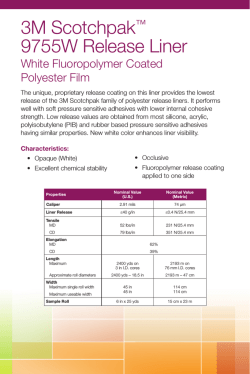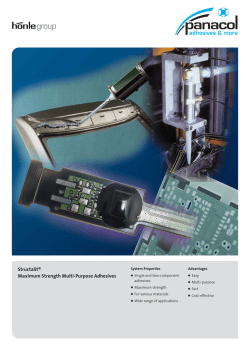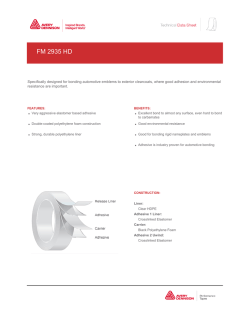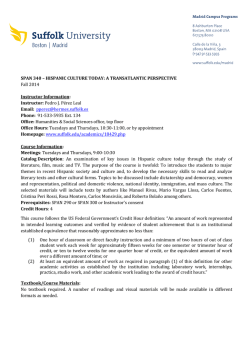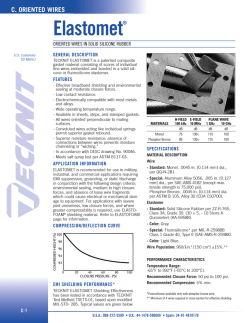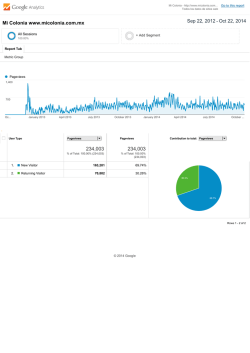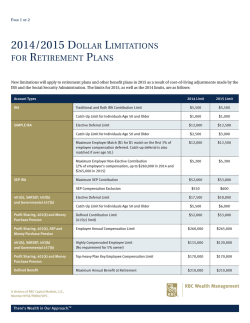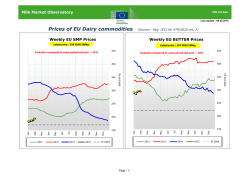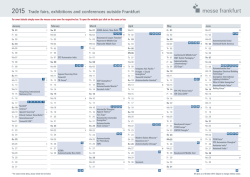
B02 - IAD2015
The 6th International Congress on Adhesive Dentistry January 30- February 1, 2015 Faculty of Dentistry, Mahidol University, BANGKOK, THAILAND For Staff Abstract number: Title: B-02 Tensile Bond Strength of a Self-Etching Ceramic-primer versus a Phosphate-Ester / Silane Ceramic Primer and Universal Adhesives Authors & affiliations: Bock T1, Koch S1, Catel D1 (1: Ivoclar Vivadent AG, Schaan, Liechtenstein) Abstract: (Your abstract format must follow as INSTRUCTION FOR ABSTRACT SUBMISSION in our official website and must fit in this box. Your abstract should not exceed 300 words. The box will ‘expand’ over 2 pages as you add text/diagrams into it.) Objectives: This study compared tensile-bond-strengths (TBS) of resin cements to lithium disilicate (LD2) of an experimental self-etching ceramic-primer (SEP) to those of a phosphate-ester / silane ceramic-primer, two universal adhesives and one 2-step self-etch adhesive. While SEP was used on un-etched LD2, the adhesives and the phosphate-ester / silane ceramic-primer were applied to 5% hydrofluoric-acid (HF)-etched LD2. Thermocycling was used to test longevity of adhesion between luting-composites and LD2. Methods: Adhesives and phosphate-ester / silane primer (Monobond Plus) were applied to HF-etched LD2 (IPS e.max CAD, Ivoclar Vivadent). SEP was applied to un-etched LD2 for 60s, rinsed with water-spray and dried with compressed air. The adhesives were light-cured before PMMA-cylinders (2.3mm) were bonded to primed LD2 using light-curing resin cements (N=6/series). After water-storage for 24h@37°C (24h) or thermo-cycling 10,000cycles/5-55°C (10kTC) to test longevity of adhesion between cement and LD2, samples were tested in a universal-testing-machine (ZWICK-ROELL, 0.8 mm/sec crosshead-speed). Data were statistically analyzed by ANOVA/Tukey-B (p<0.05). Results: Etchant 5% HF - Type Universal adhesive Ceramicprimer Universal adhesive/ CeramicPrimer Scotchbond Universal Optibond XTR All Bond Universal Monobond Plus SEP Tensile Bond Strength [MPa] Cement Manufacturer 24h 10kTC RelyX Ultimate 3M-ESPE 28.3±5.3(b) 7.9±8.3(c) Nexus NX-3 Kerr 25.1±12.5(b) 1.4±1.6(c) Duolink Bisco 29.9±9.1(b) 6.4±5.6(c) Variolink Esthetic DC IvoclarVivadent 42.1±7.1(a) 35.1±11.5(ab) 42.5±7.2(a) 47.9±6.6(a) Same letters denominate statistical equivalence. Adhesives exhibited a statistically significant lower mean TBS than ceramic-primers, with TBS decreasing significantly during thermocycling. SEP-mediated mean TBS was comparable to the phosphate-ester / silane ceramic-primer before and after thermocycling. Conclusion: Within the limitations of this study, the adhesives resulted in high immediate TBS to LD2, but are not resistant to thermal fatigue. Without HF-etching, SEP resulted in thermocycling-stable TBS, suggesting that etching/priming of silicates may be combined into one step. The new SEP and the phosphate-ester / silane ceramicprimer resulted in comparable mean TBS to LD2. Keywords: at least 3 keywords Adhesion, ceramic, tensile bond strength, longevity, universal adhesives, self-etching, primer Submitting for Outstanding Paper Award Competition Yes No For Staff Award Number:
© Copyright 2025
